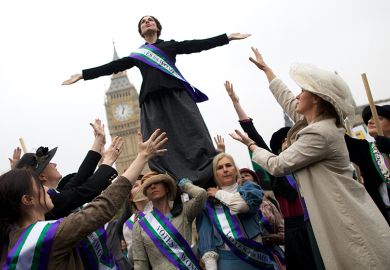An incredulous Joan Roughgarden finds an investigation of transsexualism to be worthless because it contains no reliable data.
On the US National Academies' letterhead, this book's advertisement reads: "Gay, Straight, or Lying? Science Has the Answer", and conclusions are promised that "may not always be politically correct, but... are scientifically accurate, thoroughly researched and occasionally startling." The jacket carries laudatory quotes from Steven Pinker, Simon LeVay, David Buss and other scientists. Published by a division of the National Academies Press and written by Michael Bailey, professor and chair of the psychology department at Northwestern University, the book's title is considered inflammatory - The Man who Would Be Queen: The Science of Gender-Bending and Transsexualism . Transgendered people - outraged by the book, by the National Academies' involvement and by academic psychologists'
uncritical stance - have mounted an unprecedented counterattack.
Bailey's thesis is that all transgendered women can be divided into two mutually exclusive classes: extremely feminine homosexuals and cross-dressing fetishists. This thesis is not new.
Turn-of-the-century sexologists in Europe distinguished many varieties of gender and sexual expression. Then, 20 years ago, the psychologist Ray Blanchard of the Clarke Institute in Toronto tried to argue that all transgender expression could be collapsed to the two classes Bailey is hoping to resurrect. Sexologists have not accepted Blanchard's scheme.
Bailey, upset about this, disparages his colleagues by writing:
"Blanchard's ideas have not yet received the widespread attention they deserve, in large part because sex researchers are not as scholarly as they should be and so don't read the current scientific journals."
Bailey profiles the "homosexual transsexual" as coming out early in life, attractive and sexually oriented to men. To illustrate attractiveness, Bailey writes of one, "She was stunning I My avowedly heterosexual male research assistant told me he would gladly have had sex with her, even knowing [she] still possessed a penis." In contrast, Bailey writes of the cross-dressing variety, termed "autogynephilic" by Blanchard, "There is no way to say this as sensitively as I would prefer, so I will just go ahead.
Most homosexual transsexuals are much better looking than most autogynephilic transsexuals."
Bailey profiles the cross-dressing transsexual as coming out late in life, unattractive and sexually oriented to women.
Bailey's claim that all transgendered women match one of these two profiles is clearly counterfactual. Many transgendered women come out late in life and are sexually oriented to men, many come out early in life and are oriented to women, many who are oriented to women are attractive, many change direction of sexual orientation when they transition, many are bisexual and many are not sexually active at all.
Transgendered women also encompass heterogeneity in occupation, presentation, temperament, sexual history and ethnicity. Furthermore, transgendered people are not as fixated on sex as Bailey evidently is. The need to locate in the social and occupational space of one's gender identity, to live as a woman, is stronger motivation for many transgendered women than pursuing sex.
Bailey flaunts the sensational. He writes: "Prostitution is the single most common occupation that homosexual transsexuals in our study admitted to... Juanita is a very attractive postoperative transsexual who has worked as a call girl both before and since her operation... she does not feel degraded and guilty about what she does for a living. I suspect that this reflects an aspect of her psychology that has remained male... her ability to enjoy emotionally meaningless sex appears male-typical. In this sense homosexual transsexuals might be especially suited to prostitution... Homosexual transsexuals... lust after men."
Bailey deploys the pejorative. He describes cross-dressing transsexuals as afflicted with "autogynephilia (pronounced Otto-guy-nuh-feel-ee-ya)," a "type of paraphilia... [with] unusual sexual preferences that include autogynephilia, masochism, sadism, exhibitionism... frotteurism... necrophilia, bestiality, and paedophilia... Paraphelias tend to go together... The best established link is between autogynephilia and masochism. There is a dangerous masochistic practice called 'autoerotic asphyxia', in which a man strangles himself, usually by hanging, for sexual reasons... Perhaps 100 American men per year die in this way." In about a quarter of these cases, the men are found wearing "some article of women's clothing, such as panties... Although most autogynephiles are not sexual sadists, they are more likely to be sadists compared with men who are not autogynephilic."
Thus, according to Bailey, all transsexual women are likely to be prostitutes and may be sadists. Transgendered people are scratching their heads wondering where such outlandish depictions have come from. Whether a number of men hang themselves each year wearing panties is irrelevant to how tens of thousands of transgendered people live their lives.
Bailey's book strikes me as racist. He writes: "About 60 per cent of the homosexual transsexuals and drag queens we studied were Latina or Black" (no sample size given). Bailey notices "the large number of Latina transsexuals" and offers a conjecture that "Hispanic people might have more transsexual genes than other ethnic groups do."
I also find Bailey's book homophobic and misogynist. About gays, he writes:
"The brains of homosexual people may be mosaics of male and female parts... This mixture explains much of what is unique in gay men's culture and lives." He also claims that "gay men have tended to have more of certain psychological problems than straight men".
About women, he writes: "Gay men's pattern of susceptibility to certain (but not all) mental problems reflects their femininity. The problems that gay men are most susceptible to - eating disorders, depression, and anxiety disorders - are the same problems that women also suffer from disproportionately." He continues: "Learning why gay men are more easily depressed than straight men might tell us why women are also." He then piously states: "Nothing I have written means that we should... again consider [homosexuality] a mental illness... the problems are being violent, depressed, delinquent, demented or suicidal. Homosexuality, per se, is not a problem."
Furthermore, he suggests: "Gay men will always have more sex partners than straight people do. Those who are attached will be less sexually monogamous." Then follows another pious disclaimer. "Social conservatives will view this prediction as tantamount to an admission of the inferiority of the gay male lifestyle, but it is not that." And he winds up raising the spectre of eugenics: "I certainly have no motive to change gay people or prevent them from being born."
Bailey's writing seems to me hate speech, detached from reality, and yet advertised as science and published by the US National Academies. But perhaps these hateful, politically charged claims about transgendered women, non-transgendered women, gays, Latinas and blacks are all true? Perhaps we should celebrate Bailey's honesty for bringing these painful "facts" into the open? Yet, as already mentioned, Bailey's claims are inaccurate. Might the source of the book's problem lie in his data? So, what does Bailey have to offer scientifically, leaving aside his rhetoric?
Well, Bailey has no real data, none at all: no surveys, no data tables, no statistics. He does not give the sample size for the "study" he refers to occasionally. No references are offered to primary literature either. Six transgendered people are mentioned by name (pseudonym). Bailey did not take detailed and rigorous notes when interviewing these subjects, and relies on his recollection of their meetings. This sample is highly non-representative because the women he interviewed he met while "cruising" in "the Baton, Chicago's premier female impersonator club", leading to an occupational and socioeconomic bias.
Still, one may anticipate that Bailey has at least found a tiny non-representative sample, and offers a truthful account of the life-narratives from this selected group. No, Bailey has manipulated even the few narratives he has. He admits to an "ongoing argument" with one of his subjects who will not agree to say what he wants. When his subjects disagree with him he implies they are liars. "Most gender patients lie", according to an "ace gender clinician" Bailey quotes. Also, gay males who do not report a feminine childhood are lying too because they suffer from "internalised femiphobia". Therefore, Bailey corrupts what data he has by putting words in the mouths of his interviewees.
As of August 2003, his six transgendered subjects have each filed formal complaints at Northwestern charging that Bailey did not notify them that their narratives were to be used as "research material" in his book ("Transsexuals file 2 more claims against Bailey", Daily Northwestern , August 2 2003).
After reading accounts supposedly about them, the women reported being inaccurately transcribed. In December 2003, one of the women formally charged Bailey with having sex with her at her apartment ("Northwestern U.
psychologist is accused of having sex with research subject", Chronicle of Higher Education, December 12 2003.) Bailey has declined to comment. He also did not disclose that he was writing letters for these women to authorise sex-reassignment surgeries in return for their interviews, placing the women and him in conflict of interest. And in April this year, a formal complaint was filed by three prominent transgender activists with the Illinois Department of Professional Regulation and with Northwestern charging that Bailey was functioning as a clinical psychologist without a licence. At the time of writing this review, none of these complaints has been resolved.
Last, but not least, the major narrative that frames the section in the book on transgendered women (the "Danny" narrative) is acknowledged to be fabricated. Thus, all of Bailey's narrative data are irretrievably compromised and the practices with which the information was obtained are allegedly scandalous.
All in all, Bailey's book is not only politically incorrect, it is scientifically incorrect.
Joan Roughgarden is professor of biological sciences, Stanford University, California, US.
Next week: Joan Roughgarden will contribute a feature to The Times Higher .
The Man who Would Be Queen: The Science of Gender-Bending and Transsexualism
Author - J. Michael Bailey
Publisher - Joseph Henry Press
Pages - 233
Price - £17.95
ISBN - 0 309 08418 0
Register to continue
Why register?
- Registration is free and only takes a moment
- Once registered, you can read 3 articles a month
- Sign up for our newsletter
Subscribe
Or subscribe for unlimited access to:
- Unlimited access to news, views, insights & reviews
- Digital editions
- Digital access to THE’s university and college rankings analysis
Already registered or a current subscriber?



